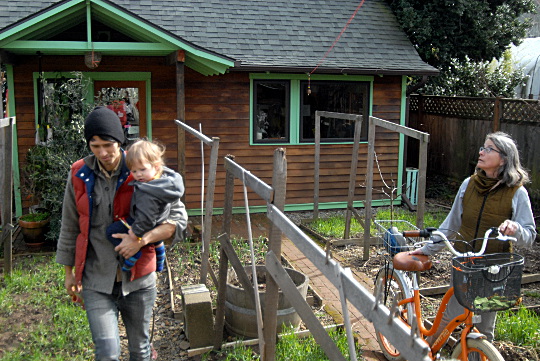
(Photo by M.Andersen/BikePortland)
When it comes to cars, accessory units in backyards and basements are nearly as low-impact as big apartment buildings next to bus lines.
That’s the conclusion of a new state-funded analysis (PDF) that combines the results of a survey of Portland accessory dwelling owners with other recent studies to start examining one of Portland’s newest real estate trends.
The average rental unit in Portland brings 1.31 cars on site, according to the U.S. Census. For transit-oriented apartment buildings, that falls to 0.83 cars — and for accessory dwelling units, it’s 0.93 cars.
In other words, transit-oriented apartments have been bringing 37 percent fewer cars into the city than the typical rental unit, and accessory dwellings (usually defined in Portland as being less than 800 square feet with a private entrance, bathroom and kitchen, among other requirements) bring in 29 percent fewer cars.
That’s the case even though Portland doesn’t restrict ADU construction to the blocks facing bus and rail lines, as it often does for new apartments.
Advertisement
As we reported in February, the number of tiny homes being built and permitted in Portland has jumped to more than 100 a year following a city decision to subsidize such homes by waiving development fees. Unlike many cities, Portland also allows property owners to rent the primary and secondary dwellings on a lot to different tenants.
“ADUs are dispersed through neighborhoods, and each additional dwelling creates only a small incremental change.”
— Martin Brown, accessory dwelling unit researcher
In the study, author Martin Brown speculates on the reasons ADUs haven’t attracted many public complaints compared to “TODs,” the transit-oriented developments that have become a lightning rod for some central-city neighborhood associations.
“TODs add a high number of living units to a small area, so any increase in vehicles will be more noticeable,” Brown suggests. “In contrast, ADUs are dispersed through neighborhoods, and each additional dwelling creates only a small incremental change.”
On the larger scale, though, Brown calculates that ADUs and transit-oriented developments have almost exactly the same impact on street parking, because ADU residents are slightly more likely to have off-street parking spaces. According to the state survey, the average Portland ADU adds 0.46 parked cars to city streets, compared to 0.49 parked cars for the average transit-oriented apartment unit.
All this summer, Brown will be writing blog posts about this and other findings from his wide-ranging study on AccessoryDwellings.org, the local website dedicated to all things ADU. Other questions include whether ADUs increase senior housing more than average (conclusion: not really), whether they increase affordable housing more than average (only inasmuch as people seem more willing to let friends or family stay in them for free) and whether they are something renters truly demand (almost certainly).
Brown tackled the project with help from Jordan Palmeri of the Oregon Department of Environmental Quality’s green building program.
— The Real Estate Beat is a weekly column. You can sign up to get an email of Real Estate Beat posts (and nothing else) here, or read past installments here. This sponsorship has opened up and we’re looking for our next partner. If interested, please call Jonathan at (503) 706-8804.



